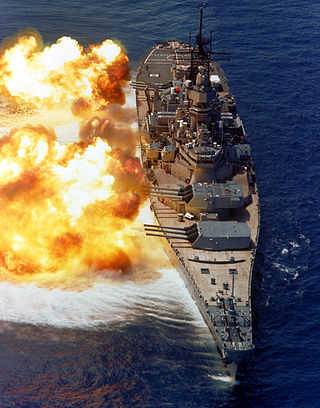
A battleship is a large armored warship with a main battery consisting of large caliber guns. It dominated naval warfare in the late 19th and early 20th centuries.

The Royal Navy (RN) is the United Kingdom's naval warfare force and a component of His Majesty's Naval Service. Although warships were used by English and Scottish kings from the early medieval period, the first major maritime engagements were fought in the Hundred Years' War against France. The modern Royal Navy traces its origins to the early 16th century; the oldest of the UK's armed services, it is consequently known as the Senior Service.

A warship or combatant ship is a ship that is built and primarily intended for naval warfare. Usually they belong to the armed forces of a nation. As well as being armed, warships are designed to withstand damage and are typically faster and more maneuverable than merchant ships. Unlike a merchant ship, which carries cargo, a warship typically carries only weapons, ammunition and supplies for its crew. Warships usually belong to a navy, though they have also been operated by individuals, cooperatives and corporations.

Woolwich Dockyard was an English naval dockyard along the river Thames at Woolwich in north-west Kent, where many ships were built from the early 16th century until the late 19th century. William Camden called it 'the Mother Dock of all England'. By virtue of the size and quantity of vessels built there, Woolwich Dockyard is described as having been 'among the most important shipyards of seventeenth-century Europe'. During the Age of Sail, the yard continued to be used for shipbuilding and repair work more or less consistently; in the 1830s a specialist factory within the dockyard oversaw the introduction of steam power for ships of the Royal Navy. At its largest extent it filled a 56-acre site north of Woolwich Church Street, between Warspite Road and New Ferry Approach; 19th-century naval vessels were fast outgrowing the yard, however, and it eventually closed in 1869. The former dockyard area is now partly residential, partly industrial, with remnants of its historic past having been restored.

The County class was a class of British guided missile destroyers, the first such warships built by the Royal Navy. Designed specifically around the Seaslug anti-aircraft missile system, the primary role of these ships was area air defence around the aircraft carrier task force in the nuclear-war environment.
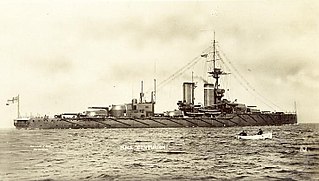
HMS Centurion was the second of four King George V-class dreadnought battleships built for the Royal Navy in the early 1910s. She spent the bulk of her career assigned to the Home and Grand Fleets. Aside from participating in the failed attempt to intercept the German ships that had bombarded Scarborough, Hartlepool and Whitby in late 1914, and the Battle of Jutland in May 1916, her service during the First World War generally consisted of routine patrols and training in the North Sea.

The Valiant class were a class of nuclear-powered fleet submarines in service with the Royal Navy from the mid-1960s until 1994. They were the first fully British nuclear fleet submarine; the earlier HMS Dreadnought used an American nuclear reactor. There were only two boats in the class, the first, Valiant commissioned in 1966 three years after Dreadnought, and Warspite the following year. Both were built by Vickers at Barrow-in-Furness.

HMS Dreadnought was a Royal Navy battleship the design of which revolutionised naval power. The ship's entry into service in 1906 represented such an advance in naval technology that her name came to be associated with an entire generation of battleships, the dreadnoughts, as well as the class of ships named after her. Likewise, the generation of ships she made obsolete became known as pre-dreadnoughts. Admiral Sir John "Jacky" Fisher, First Sea Lord of the Board of Admiralty, is credited as the father of Dreadnought. Shortly after he assumed office in 1904, he ordered design studies for a battleship armed solely with 12 in (305 mm) guns and a speed of 21 knots. He convened a Committee on Designs to evaluate the alternative designs and to assist in the detailed design work.

His Majesty's Naval Base, Portsmouth is one of three operating bases in the United Kingdom for the Royal Navy. Portsmouth Naval Base is part of the city of Portsmouth; it is located on the eastern shore of Portsmouth Harbour, north of the Solent and the Isle of Wight. For centuries it was officially known as HM Dockyard, Portsmouth: as a Royal Dockyard, Portsmouth functioned primarily as a state-owned facility for building, repairing and maintaining warships; for a time it was the largest industrial site in the world.
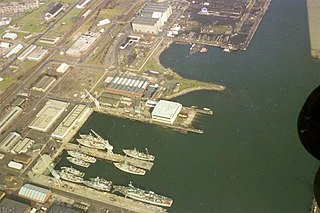
Rosyth Dockyard is a large naval dockyard on the Firth of Forth at Rosyth, Fife, Scotland, owned by Babcock Marine, which formerly undertook refitting of Royal Navy surface vessels and submarines. Before its privatisation in the 1990s it was formerly the Royal Naval Dockyard Rosyth. Its primary role now is the dismantling of decommissioned nuclear submarines. It is also the integration site for the Royal Navy's newest aircraft carriers, the Queen Elizabeth class as well as the Type 31 Frigate.

Sir Thomas Slade was an English naval architect best known for designing the Royal Navy warship HMS Victory, which served as Lord Nelson's flagship at the Battle of Trafalgar in 1805.

The Director of Naval Construction (DNC) also known as the Department of the Director of Naval Construction and Directorate of Naval Construction and originally known as the Chief Constructor of the Navy was a senior principal civil officer responsible to the Board of Admiralty for the design and construction of the warships of the Royal Navy. From 1883 onwards he was also head of the Royal Corps of Naval Constructors, the naval architects who staffed his department from 1860 to 1966. The (D.N.C.'s) modern equivalent is Director Ships in the Defence Equipment and Support organisation of the Ministry of Defence.
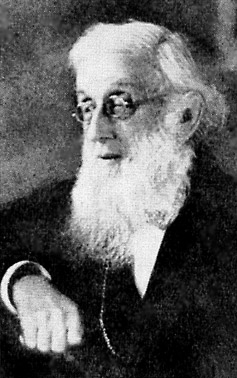
Sir Nathaniel Barnaby, was Chief Constructor of the Royal Navy from 1872 to 1885.
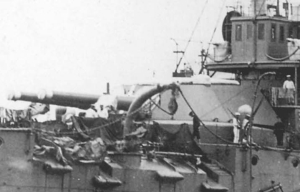
The Armstrong Whitworth 12-inch naval gun of 40 calibres length was designed by and manufactured mainly by Armstrong's ordnance branch, Elswick Ordnance Company. It was intended for the Royal Navy's Royal Sovereign-class battleships, but budgetary constraints delayed their introduction. The first units were instead supplied to Japan. As the Type 41 12-inch (305 mm) 40-calibre naval gun it was the standard main battery on several early United Kingdom-built pre-dreadnought battleships of the Imperial Japanese Navy.
David K. Brown (1928–2008) was a noted British naval architect. Born in Leeds, he joined the Admiralty and became a member of the Royal Corps of Naval Constructors. He rose through the ranks to become the Deputy Chief Naval Architect, before retiring in 1988.
John Harper Narbeth, CB, CBE, MVO was a British naval architect of the Royal Corps of Naval Constructors, the body responsible for the design of Royal Navy warships. The design of the dreadnought battleships has been attributed to him, and he played a leading part in the design and construction of the first generation of aircraft carriers.
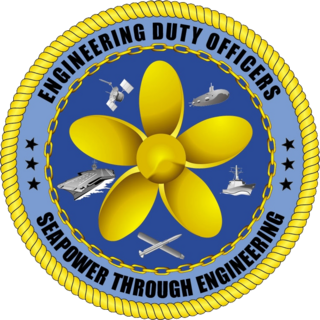
An engineering duty officer (EDO) is a restricted line officer in the United States Navy, involved with the design, acquisition, construction, repair, maintenance, conversion, overhaul and disposal of ships, submarines, aircraft carriers, and the systems installed aboard. As of August 1, 2016, there are approximately 835 engineering duty officers on active duty in the U.S. Navy, representing approximately 2 percent of its active-duty commissioned officers.
In 1989 the Royal Navy was under the direction of the Navy Department in the UK Ministry of Defence. It had two main commands, CINCFLEET and Naval Home Command.
Keith Foulger was a British naval architect. As a child he aspired to a career as a Royal Navy officer but failed the eyesight requirements and so started a career in naval architecture. Foulger joined the Royal Corps of Naval Constructors and worked on designs for the Porpoise and Explorer-class submarines. Following the 1958 US–UK Mutual Defence Agreement Foulger was chosen to lead a team to observe the construction of the Skipjack-class submarine being constructed for the US Navy. The first British nuclear submarine HMS Dreadnought would use the same reactor and so the aft portion had to accommodate that design. Foulger's job was to minimise any mismatch between this portion and the forward section which was to be a wholly British design.

















